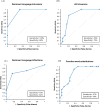Bilingual language intrusions and other speech errors in Alzheimer's disease
- PMID: 28753438
- PMCID: PMC5595660
- DOI: 10.1016/j.bandc.2017.07.007
Bilingual language intrusions and other speech errors in Alzheimer's disease
Abstract
The current study investigated how Alzheimer's disease (AD) affects production of speech errors in reading-aloud. Twelve Spanish-English bilinguals with AD and 19 matched controls read-aloud 8 paragraphs in four conditions (a) English-only, (b) Spanish-only, (c) English-mixed (mostly English with 6 Spanish words), and (d) Spanish-mixed (mostly Spanish with 6 English words). Reading elicited language intrusions (e.g., saying la instead of the), and several types of within-language errors (e.g., saying their instead of the). Patients produced more intrusions (and self-corrected less often) than controls, particularly when reading non-dominant language paragraphs with switches into the dominant language. Patients also produced more within-language errors than controls, but differences between groups for these were not consistently larger with dominant versus non-dominant language targets. These results illustrate the potential utility of speech errors for diagnosis of AD, suggest a variety of linguistic and executive control impairments in AD, and reveal multiple cognitive mechanisms needed to mix languages fluently. The observed pattern of deficits, and unique sensitivity of intrusions to AD in bilinguals, suggests intact ability to select a default language with contextual support, to rapidly translate and switch languages in production of connected speech, but impaired ability to monitor language membership while regulating inhibitory control.
Keywords: Alzheimer’s disease; Bilingualism; Diagnosis; Reading-aloud; Speech errors; Switching.
Copyright © 2017 Elsevier Inc. All rights reserved.
Conflict of interest statement
The authors declared that they had no conflicts of interest with respect to their authorship or the publication of this article.
Figures





Similar articles
-
Intact reversed language-dominance but exaggerated cognate effects in reading aloud of language switches in bilingual Alzheimer's disease.Neuropsychology. 2020 Jan;34(1):88-106. doi: 10.1037/neu0000592. Epub 2019 Sep 23. Neuropsychology. 2020. PMID: 31545627 Free PMC article.
-
A switch is not a switch: Syntactically-driven bilingual language control.J Exp Psychol Learn Mem Cogn. 2018 Jan;44(1):143-156. doi: 10.1037/xlm0000462. Epub 2017 Aug 7. J Exp Psychol Learn Mem Cogn. 2018. PMID: 28782969 Free PMC article.
-
Multiple levels of bilingual language control: evidence from language intrusions in reading aloud.Psychol Sci. 2014 Feb;25(2):585-95. doi: 10.1177/0956797613512661. Epub 2013 Dec 23. Psychol Sci. 2014. PMID: 24367061 Free PMC article.
-
Language changes in bilingual individuals with Alzheimer's disease.Int J Lang Commun Disord. 2016 Mar;51(2):113-27. doi: 10.1111/1460-6984.12190. Epub 2015 Oct 18. Int J Lang Commun Disord. 2016. PMID: 26477451 Review.
-
Can Speaking More Than One Language Help Prevent Alzheimer's Disease?J Alzheimers Dis. 2023;95(2):363-377. doi: 10.3233/JAD-230285. J Alzheimers Dis. 2023. PMID: 37545240 Review.
Cited by
-
Failure to stop autocorrect errors in reading aloud increases in aging especially with a positive biomarker for Alzheimer's disease.Psychol Aging. 2020 Nov;35(7):1016-1025. doi: 10.1037/pag0000550. Epub 2020 Jun 25. Psychol Aging. 2020. PMID: 32584071 Free PMC article.
-
Older bilinguals reverse language dominance less than younger bilinguals: Evidence for the inhibitory deficit hypothesis.Psychol Aging. 2021 Nov;36(7):806-821. doi: 10.1037/pag0000618. Epub 2021 Jun 24. Psychol Aging. 2021. PMID: 34166027 Free PMC article.
-
Codeswitching: A Bilingual Toolkit for Opportunistic Speech Planning.Front Psychol. 2020 Jul 17;11:1699. doi: 10.3389/fpsyg.2020.01699. eCollection 2020. Front Psychol. 2020. PMID: 32765377 Free PMC article.
-
Bilingualism: Pathway to Cognitive Reserve.Trends Cogn Sci. 2021 May;25(5):355-364. doi: 10.1016/j.tics.2021.02.003. Epub 2021 Mar 23. Trends Cogn Sci. 2021. PMID: 33771449 Free PMC article. Review.
-
What about proactive language control?Psychon Bull Rev. 2020 Feb;27(1):24-35. doi: 10.3758/s13423-019-01654-1. Psychon Bull Rev. 2020. PMID: 31410740 Free PMC article. Review.
References
-
- Abutalebi J, Green D. Control mechanisms in bilingual language production: Neural evidence from language switching studies. Language and Cognitive Processes. 2008;23:557–582.
-
- Abutalebi J, Green DW. Bilingual language production: The neurocognition of language representation and control. Journal of Neurolinguistics. 2007;20:242–275.
-
- Adlam AL, Patterson K, Rogers TT, Nestor PJ, Salmond CH, Acosta-Cabronero J, et al. Semantic dementia and fluent primary progressive aphasia: Two sides of the same coin? Brain. 2006;129:3066–3080. - PubMed
-
- Agosta F, Pievani M, Geroldi C, Copetti M, Frisoni GB, Filippi M. Resting state fMRI in Alzheimer's disease: beyond the default mode network. Neurobiology of Aging. 2012;33:1564–1578. - PubMed
-
- Almor A, Kempler D, MacDonald MC, Andersen ES, Tyler LK. Why do Alzheimer patients have difficulty with pronouns? Working memory, semantics, and reference in comprehension and production in Alzheimer’s disease. Brain and Language. 1999;67:202–227. - PubMed
MeSH terms
Grants and funding
LinkOut - more resources
Full Text Sources
Other Literature Sources
Medical

